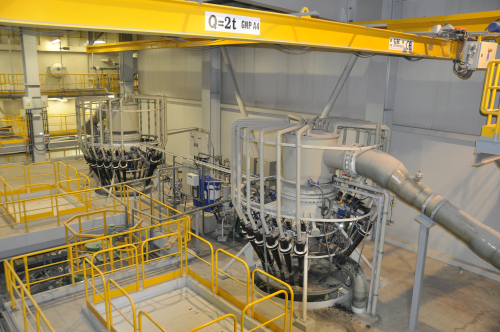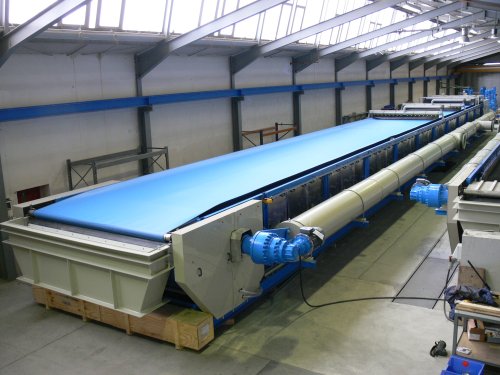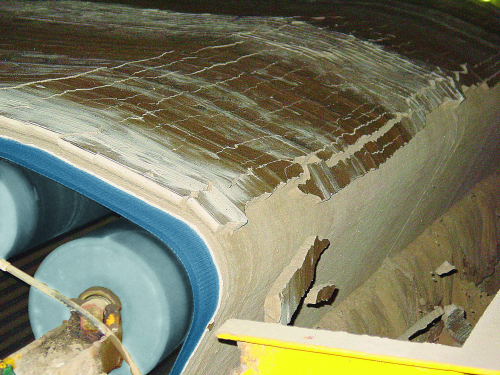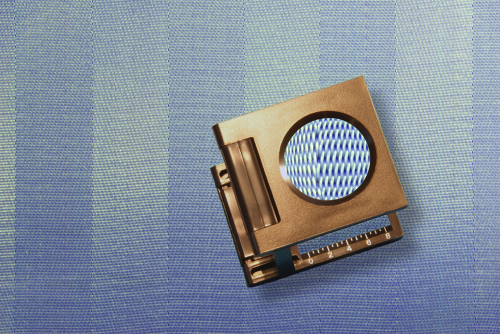



After petroleum, coal remains the world’s next most important fossil energy source. In 2010 it accounted for 30% of global primary energy consumption [DERA, 2010], while in Germany just under 40% of domestic power generation came from coal. Indeed in 2009 every fourth kilowatt hour of power consumed in Germany came from brown coal [DEBRIV, 2010.02] and domestic mineral coal production is on the decrease due to the loss of subsidies in 2018. In contrast, significantly more mineral coal than brown coal is produced globally. Flue gases formed through the burning of coal needs to be scrubbed in an ecologically responsible way - in flue gas desulphurisation plants (FGD). Gypsum is a by-product of the FGD process – about 7 million tonnes are produced annually worldwide [BVK]. This base material is required in the construction and cement industry in very large quantities, for example in the manufacture of drywall/plasterboard. VACUBELT filter cloths for vacuum belt filter systems have been developed by German company GKD – Gebr. Kufferath AG specifically to meet the demanding conditions for FGD gypsum dewatering in large coal power stations.
Environmental standards
In 2007, 5.5 gigatonnes (5.5 billion tonnes) of hard coal (hard brown coal, mineral coal and anthracite coal) and 0.98 gigatonnes of soft brown coal were produced throughout the world. China is the country that produces the most hard coal (2.5 gigatonnes), followed by the USA (0.97 gigatonnes), India (0.45 gigatonnes), Australia (0.32 gigatonnes) and South Africa (0.24 gigatonnes) [DERA, 2010]. As well as increasing production volumes, newly constructed power stations, station expansions and renovations are also booming. It is the aim of these activities to increase the efficiency of coal conversion into electricity, while continuing to decrease emissions through improved technologies for dedusting, denitrifying and desulphurising flue gases. One of these power stations of the future is in Neurath, Germany, in the form of two new brown coal power station blocks. Each of these power station blocks has a gross output of 1,100 megawatts and an efficiency factor of more than 43%. Its optimised plant technology is basically in line with the blocks already in place, but the new ones make much better use of the fuel. As a result, efficiency is increased by about 31% compared with the existing plants. Consequently, gas and dust emissions are also reduced. For example, in the flue gas desulphurisation plant, more than 90% of the sulphur dioxide is separated and transformed into gypsum slurry. This is then condensed and the 60-65°C gypsum suspension is dewatered in vacuum belt filters in a continuous process. This operation imposes tough demands on the mechanical, thermal and chemical capacity of the filter belts used.
Filter belt selection
The core of the new system for FGD gypsum dewatering in Neurath consists of two 35 metre long and 3.5 metre wide vacuum belt filter installations from the international plant manufacturer FLSmidth. With a total filter surface area of 93 square metres each, they are among the largest FGD belt filters in the world. For many years FLSmidth has been relying on VACUBELT FGD gypsum filter cloths from GKD. In 2008 the two new blocks in Neurath were equipped with the double-layered VACUBELT 2025 filter belt. In this case, a twilled two-ply mesh made of polyester monofilaments with staple fibres was used. The reliability and efficiency of these belts had been observed at several other power stations by Thomas Triebert, senior sales manager Power/FGD at FL Smidth. He selected the new VACUBELT 2015 belt type made entirely of polyester monofilaments. The mesh design with more pores per square metre and smaller openings proved itself to be particularly efficient. With greater air permeability, faster dewatering and the fact that the mesh did not block up and was easier to clean, the VACUBELT 2015 outperformed conventional belts. The test run of the systems began in 2011. The gypsum suspension with 15% solids content is condensed in hydrocyclones and then, with a solid content of 50-60%, it is spread on the giant vacuum belt filters. The belt filters extract more than 90% moisture from 81 tonnes of gypsum an hour – operating non-stop. The filtrate purity realised is under 0.5% with dry matter of 8%. Detlev Stronczek, head of sales Power Plant-Processing at ThyssenKrupp Fördertechnik (TKF), has also been using this belt type in various vacuum belt filters for FGD gypsum dewatering since 2009 in the Rheinhafen-Dampfkraftwerk Karlsruhe, Datteln 4 and Maasvlakte (Netherlands) mineral coal power stations and in the Belchatov (Poland), Turcini (Romania) and Maritza II (Bulgaria) brown coal power stations. At the Belchatov power station, for example, 12 blocks makes this the largest brown coal power station in the world, supplying a total output of 4,400 megawatts of electricity. ThyssenKrupp Fördertechnik had already equipped six of these blocks, four with complete belt filter systems and two with hydrocyclones, and was also commissioned to supply a 13th block which is to produce another 850 megawatts of electricity. Three vacuum belt filters, each with 55 square metres of filter surface area, were installed in 2011. TKF equipped all three with VACUBELT filter belts. According to Detlev Stronczek, in addition to the high air flow rate and the optimised dewatering effect, the polyester monofilament’s thermal resistance is particularly significant. He cites the cross-stability and smooth belt surface as another advantage, whereby the belt can be easily cleaned by spray pipes in the integrated cleaning unit. Moreover, the smooth surface texture reduces the possibility of confusion because the cloth can be applied from either side. Due to its mechanical sturdiness the VACUBELT 2015 can be adjusted to an operational speed in line with demand. This is claimed to be a particular advantage in providing major flexibility in throughput times and nominal thickness as regards non-contract specific feeding quality for gypsum suspension in particular. Immediately the continuous density measurement detects aberrant solid matter concentrations in the flue gas scrubber, the system will automatically run faster or slower in order to achieve optimum results. The spreader vanes typical of TKF systems in suspension feeding also ensure uniform spreading of the gypsum suspension and unvarying dewatering efficiency even at different speeds. Belt filters equipped with VACUBELT 2015 belts reduce residual gypsum moisture permanently to under 10% and at Belchatov produce 45 tonnes per unit per hour.
Worldwide applications
GKD has also supplied more than 15 power stations in the USA, with an output volume of 1-2.7 gigawatts, with over 35 VACUBELT belts on average every year. The all-monofilament VACUBELT 2015 is the most common belt size, and is 50 etres long and 3 metres wide. But the two-ply belt types are being used in the USA as well, such as the VACUBELT 2025 with staple fibres and the VACUBELT 2035 with multifilament weft wires. In South Africa the Kusile mineral coal power station, 100 kilometres east of Johannesburg, was equipped with high-performance VACUBELT 2015 belts in 2011. With 4,800 megawatts of rated output, Kusile is ranked among the largest coal power stations in the world.






